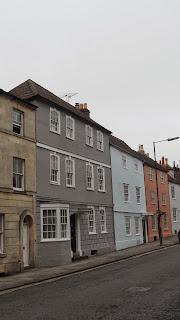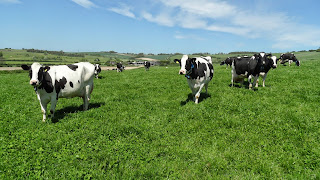Having washed, blow-dried and fluffed up Renee the Renault Captur yesterday, we were anxious to drop it off at Hertz Heathrow this morning without any dramas. And we did! It was quite a relief to be shot of it. Svetlana (the highly efficient, no-nonsense Hertz inspector) pronounced our cleaning and maintenance effort satisfactory and conceded that yes, indeed, Geoff would get his security deposit back. Good work, Geoffy. 3000 miles and nary a scratch, although we did have some close calls, especially with combine harvesters hurtling along country lanes in the opposite direction.
After walking away from Renee, we got a shuttle bus to our terminal, dumped our bags at a bag-dumping place (40 pounds! but when one has 12 hours to kill, who wants to lug their bags all round London?) and then had a very pleasant meander around the Tower Bridge area, where we saw this sign:
 Crutched Friars is adjacent to Seething Lane,
Crutched Friars is adjacent to Seething Lane,where Samuel Pepys used to live. It was a short, brisk walk down to the Tower of London where Sam often spent an absorbing afternoon watching those convicted of treason being hung, drawn and quartered.
Geoffy will talk at more length about being hung, drawn and quartered in just a mo.

Who remembers that the 1666 Great Fire of London began in Pudding Lane? Only Australians over 55 I suspect. Everyone younger participated in a more relevant history curriculum. Anyway, this is Pudding Lane today. I wasn't expecting still-smouldering buildings, but gee, not a skerrick of musty age remains. And in the background, but not obvious, is That Most Putrescent Vominess, The Shard! Scourge of good taste, monument to unbridled capitalism. Everywhere we looked today it was there, leering and sneering and glittering at us. Shudder!
This afternoon we had another catch-up with my old school pal Cathy Shepherd, who we met today at Sloane Square. Neither Geoff nor I had been there before and it was fascinating to see where the young, rich, braying, upper classes congregate on weekends. We had a lovely wander around Chelsea and an excellent cup of tea and a bun in a local patisserie. We also saw the teeming hordes spilling out of the Chelsea Flower Show - all looking tired and grumpy and carrying heaps of petunias. It was just like Children's Day at Sydney's Royal Easter Show - except everyone was grown up and carrying plants instead of show bags. A very London way to spend our last afternoon in the old dart. Thanks Cathy. xxx
Handing over to Geoff imminently. Will just finish by saying I adore this country. But its shower/bathtub thang is non-intuitive and stupid, and both the tap water and bottled water taste so bad there must be a dead pigeon somewhere in the upper reaches of the water table. Otherwise excellent. Four and half stars from me. xxxxx
Anne's reference to Pepys is a generous segue into our visit to the Hung Drawn and Quartered.
We originally headed for the Liberty Bounds, a most convivial hostelry that we remembered from the Tower Bridge area two years ago. Alas, it was full to overflowing, with no chance at all of anything resembling a table. And worse still, I was convinced that most of the patrons were heading to a soccer game involving Southend United, otherwise known as the pride of Essex. Hence our decision to head instead over the road to the Hung etc. A plaque on the side makes reference to a quotation from Pepys that dates from 1660 that included 'hung, drawn and quartered'. We'll have to take their word for it. Bu the point needs to be made that, despite the antiquity of the quote, the building itself has only been a pub since 1996! A bit of a come down, huh? We intended to lunch there, but our waitress, for whom English was about her fifth language, managed to convey that there was a problem with the kitchen. So the decision was made to abandon the Hung after one drink, and head elsewhere. But not before meeting yet more Southend supporters, who were only too happy to take over our table.
Anyway, moving right along (looking at the clock, and the looming boarding time), we did enjoy our afternoon in Chelsea. Here is a sample of the thousands of Chelsea Flower Show patrons heading home with their mementos of the big day ...
... to be specific, on Sloane Square station, all very happy with themselves. This doesn't really do the scene justice, but you'll just have to take our word for it - never seen anything like so many grown adults lugging huge bunches and pots of pelargoniums and agapanthus in all me born days. Only in London!
I was going to close with some final observations of England, but I fear time has beaten me. So here we are at Heathrow's finest all-you-can-eat buffet, [and all you can drink - hic! Ed.] bidding a fond farewell. Thanks for listening; we've had a ball!
















































